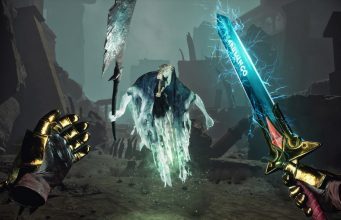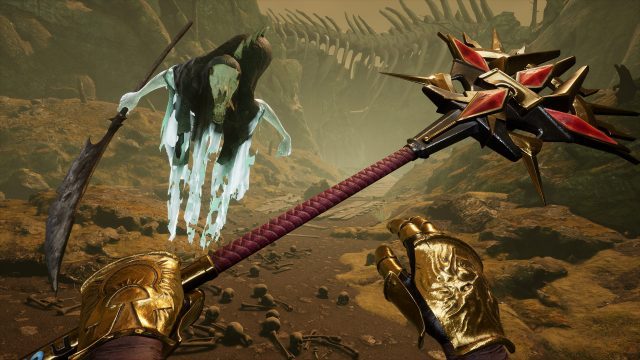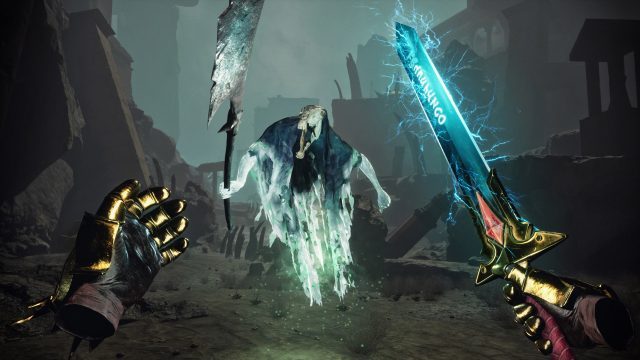
Warhammer: Age of Sigmar – Tempestfall is the latest and most ambitious title from Carbon Studio which cut its teeth building VR spellcasting game The Wizards. In Tempestfall, the studio attempts to bring melee into the mix, alongside a dark fantasy story set in the vast Warhammer universe, but ultimately falls well short of what it set out to achieve.
Warhammer: Age of Sigmar – Tempestfall Details:
Available On: Steam
Release Date: November 17th, 2021
Price: $30
Developer: Carbon Studio
Reviewed On: Valve Index
Gameplay
Warhammer: Age of Sigmar – Tempestfall puts players in the boots of a Lord-Arcanum, the leader of a group of Stormcast Eternals—armor clad warriors who fight on behalf of the god Sigmar.
Tempestfall is a linear action game that combines spellcasting with melee fighting. While it does the former rather well, the latter is a troubling affair.
Players can choose between three weapons and can duel-wield any combination of them on the fly. Each weapon can be swung to strike enemies directly, or can be used to cast unlockable spells (three unique spells for each weapon). Each of the three spells is activated with one of three gestures; while holding the trigger: raise the weapon above your head, swing it horizontally, or jab it forward.

The sword, for instance, can shoot ranged bolts of energy when swinging horizontally. Jabbing it forward initiates a powerful lunging strike. Raising it above your head empowers the sword to do extra damage on the next few swings.
While it takes a little while to get the gestures and the timing down just right, I found that the spellcasting aspect of the game works quite well and is easily the most fun part of the combat. Unfortunately the enemy AI is, for the most part, programmed to get right up in your face to engage in melee combat, an area where the game really falters.
Though Tempestfall takes clear influence from the likes of the brilliant Until You Fall, it fails to recreate the game’s key innovation—clearly defined combat pacing.
Like Until You Fall, Tempestfall uses a mostly gestural melee combat system rather than being heavily physics-based. The game will display visual indicators to show which direction you should swing in order to parry an incoming attack. Though you can optionally turn this off, it seems entirely essential because enemy attacks can be difficult, somethings frustratingly so, to read. If you swing at the right time the enemy’s attack is parried and all damage is spared.
But a core issue with the combat is that parrying is extremely lenient and will frequently be granted as long as you’re swinging at all. This means you can basically just wail on the enemy and you’ll parry most attacks by accident.
This itself might not be so much of an issue, but it’s a part of a broader problem of a serious ‘game feel’ issue. Swinging and hitting enemies just doesn’t feel very satisfying, and there is way too many instances of your swings simply not making contact, whether that’s because of unclear combat pacing, hit detection problems, or enemies attacking you from outside the reach of your weapon.
The problem is exacerbated by the enemy design. The main enemies you fight are wraith-like creatures that float around and—between their AI and animations—do a poor job of being a clear and predictable target or making it easy to read when, where, and how they will attack.

Enemy variety is also a huge issue in the game. There’s essentially one enemy type that you fight about 80% of the time (the aforementioned wraiths) and four lesser seen enemy types. None of them present particularly unique challenges, nor does the environment influence the combat at any point in the game.
That means the vast majority of fights feel practically the same; half way through I found myself groaning every time I came upon a large open space where it was obvious that the generic fight music would start and a wave of the same old enemies would simply be spawned in front of me. It feels like every five minutes you walk into another room for another bland fight.
Beyond the combat there’s a world to explore and a story to follow.
The game world is largely linear but has some branching paths that can feel labyrinthine at times. Without a map it’s easy to get turned around and resort to wandering the halls until you find the right way to your next objective. This is made a bit more annoying by recurring enemy engagements in areas you already cleared if you loaded into another area before returning.
Exploration is rewarded with resources which can be used to upgrade your weapons and books that award lore pages. It’s a shame that the game’s structure doesn’t make it easy to return to the hub (where you can upgrade your weapons) more frequently. It would have been better to upgrade weapons regularly instead of getting a huge power spike late in the game once you finally return to spend all your resources.
Unfortunately any real substance to the story is buried somewhere in text-based lore which you can read in the game’s menu at your leisure (or not). The surface level story that’s presented to you is little more than a backdrop to combat and some exploration. There’s zero character development, so don’t expect to have any idea about what you’re actually doing or why it matters (unless you’re already stepped in Warhammer lore, perhaps).
In an exceptionally rare occurrence, I didn’t completely finish Tempestfall. I quit after my fifth or so attempt on the final boss fight which frustrated me to the point of not wanting to play any longer. As with other enemies, the boss’s animations and movements make it exceptionally difficult to read. Knowing how far its attacks would reach, when to parry, and when it will or won’t be invulnerable, felt like a guessing game. By the time I quit I had clocked nearly seven hours of game time after having found a majority of the game’s hidden resources and tackling some of the smattering of side quests.
Immersion
Tempestfall suffers from a general lack of polish that really hampers immersion. The game at times could probably be called “decent looking”, but inconsistent art direction and asset quality, weak sound design, amatuer-level animations, and poor writing and voice work really crush the soul of the game.
If nothing else, one would hope that the core melee combat would be solid in all of these areas, but unfortunately that’s not the case. Time and time again I would swing my weapons at enemies and have my hits completely not register, as if I was swinging at nothing but air. I couldn’t nail down exactly when enemies would or wouldn’t be vulnerable; wailing at them and watching several swings in a row not make any contact whatsoever was regularly frustrating.
Inconsistent interaction quality was another immersion-breaker. While a handful of interactive elements in the game were functional and satisfying (like most levers and switches), many of the interactions were janky or unintuitive, to the point of causing confusion.
For instance, at one point in the game I pulled a lever to lower a gate that was blocking an elevator. Behind the gate, however, there was another gate blocking my way. I wandered the environment looking for another lever or some way to open the second gate but found nothing. After searching around fruitlessly, it eventually dawned on me that the second gate might actually be a door (despite there being no handle or clear visual indicator that it could be interacted with). I walked up and attempted to push the gate open but it didn’t move. But once I tried pulling it (again, with no handle to clearly grab), it swung right open.
I ran into a handful of these moments where I thought I needed to look for some puzzle or alternate route, only to find that I was actually in the right place but simply not understanding that something could be interacted with. I have a feeling players will commonly get stuck at such points and need to consult the internet to figure out how to move forward.
Comfort

Tempestfall seems designed largely around smooth movement, but its systems generally work well enough with teleport, despite one huge caveat: there are large swaths of the game world that you simply cannot teleport onto. You’ll be zipping along one moment and then come to a bridge, for instance, which you can’t teleport onto because the teleport detection is broken.
If you attempted to play the game with the teleport option only, you couldn’t actually complete the game due to these impassable areas. If you’re someone who must stick strictly to teleport for comfort, do not consider playing Tempestfall unless it gets updated with a full pass to fix teleport collision issues.
Fortunately the game supports a teleport and smooth movement option which allows you to do either at any given time. This can be used to temporarily revert to smooth movement to scoot along until you can finally teleport again. Still, if you want to play with teleport, the inconsistency and need to fall back to smooth movement regularly is a drag, especially in the heat of combat.
Beyond walking around on flat ground there’s also a handful of climbing and zipline sections in the game which you can choose to undertake or skip by clicking a nearby button. That’s a thoughtful option for those that would get dizzy from climbing, and even more thoughtful that you can disable the skip button if you know you always want to tackle those segments by hand.
Some parts of the game ask the player to drag large objects, but this is extremely awkward if not impossible to do with teleport movement. You can always fall back to free movement in these movements, but that may come at a comfort cost for some.
Warhammer Tempestfall’ Comfort Settings – November 17th, 2021 |
|
Turning |
|
| Artificial turning |  |
| Smooth-turn |  |
| Adjustable speed |  |
| Snap-turn |  |
| Adjustable increments |  |
Movement |
|
| Artificial movement |  |
| Smooth-move |  |
| Adjustable speed |  |
| Teleport-move |  |
| Blinders |  |
| Adjustable strength |  |
| Head-based |  |
| Controller-based |  |
| Swappable movement hand |  |
Posture |
|
| Standing mode |  |
| Seated mode | not explicit |
| Artificial crouch |  |
| Real crouch |  |
Accessibility |
|
| Subtitles |  |
| Languages |
English, French, Italian, German, Spanish, Japanese, Korean, Russian, Simplified Chinese
|
| Alternate audio |  |
| Languages | English |
| Adjustable difficulty |  |
| Two hands required |  |
| Real crouch required |  |
| Hearing required |  |
| Adjustable player height |  |
Overall Score: 4 – OK
WE SCORE ON A LINEAR SCALE – Learn More
Warhammer: Age of Sigmar – Tempestfall brings some good ideas to the table but only executes a few of them well. While the game’s ranged spellcasting is satisfying and fun, most of the focus is put into a shoddy melee system that’s functional at best and frustrating at worst, with enemy design and variety only exacerbating the issue. With inconsistent art direction and asset quality, weak sound design, amatuer-level animations, and poor writing, Tempestfall feels like a clear case of trying to do too much with too little.
Gameplay: 4 | Immersion: 5 | Comfort: 6
The post ‘Warhammer: Tempestfall’ Review – Swinging at Ghosts and Hitting Air appeared first on Road to VR.
from Road to VR https://ift.tt/2YYIQvl
via IFTTT
No comments:
Post a Comment